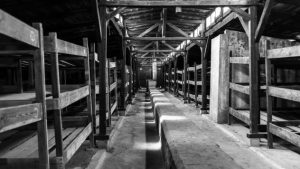 Technology
Technology  Technology
Technology  Humans
Humans 10 Everyday Human Behaviors That Are Actually Survival Instincts
 Animals
Animals 10 Animals That Humiliated and Harmed Historical Leaders
 History
History 10 Most Influential Protests in Modern History
 Creepy
Creepy 10 More Representations of Death from Myth, Legend, and Folktale
 Technology
Technology 10 Scientific Breakthroughs of 2025 That’ll Change Everything
 Our World
Our World 10 Ways Icelandic Culture Makes Other Countries Look Boring
 Misconceptions
Misconceptions 10 Common Misconceptions About the Victorian Era
 Mysteries
Mysteries 10 Strange Unexplained Mysteries of 2025
 Miscellaneous
Miscellaneous 10 of History’s Most Bell-Ringing Finishing Moves
 Technology
Technology Top 10 Everyday Tech Buzzwords That Hide a Darker Past
 Humans
Humans 10 Everyday Human Behaviors That Are Actually Survival Instincts
 Animals
Animals 10 Animals That Humiliated and Harmed Historical Leaders
Who's Behind Listverse?

Jamie Frater
Head Editor
Jamie founded Listverse due to an insatiable desire to share fascinating, obscure, and bizarre facts. He has been a guest speaker on numerous national radio and television stations and is a five time published author.
More About Us History
History 10 Most Influential Protests in Modern History
 Creepy
Creepy 10 More Representations of Death from Myth, Legend, and Folktale
 Technology
Technology 10 Scientific Breakthroughs of 2025 That’ll Change Everything
 Our World
Our World 10 Ways Icelandic Culture Makes Other Countries Look Boring
 Misconceptions
Misconceptions 10 Common Misconceptions About the Victorian Era
 Mysteries
Mysteries 10 Strange Unexplained Mysteries of 2025
 Miscellaneous
Miscellaneous 10 of History’s Most Bell-Ringing Finishing Moves
10 Incredible Discoveries That Were Announced This Year
Given that Earth is estimated to be 4.5 billion years old, it would only be natural to assume that by this point in time, scientists, historians, and archaeologists have unearthed so many of the world’s treasures that there simply isn’t much left to discover. However, despite the fact that some of the most remote locations on land and in the oceans have previously been explored, this list proves that that assumption couldn’t be further from the truth.
Thanks to new tools and advancements in technology, exploration is not only easier than in times past but is now even more vital as a way to further our understanding of the planet we call home. In light of these advancements, it seems that the secrets and hidden treasures of planet Earth, its people, and the animals who call it home continue to reveal themselves.
In fact, this year alone, several notable discoveries were announced. From capturing distinct animal behavior on record for the first time to locating significant historical artifacts to discovering a new tree species that would seemingly only exist in a children’s book to documenting relics once thought lost to the sea, these spectacular finds shed new light on the concealed mysteries of history and nature. They challenge our previous perceptions and cause us to realize that even on a planet that is billions of years old, there is still much left to learn.
Here are ten incredible discoveries that were made or announced this year.
Related: 10 Significant Biblical Archaeology Discoveries
10 Burial Rituals of Asian Elephants
While the Asian elephant is distinguished from its African cousin by its smaller stature, smaller, more rounded ears, and twin-domed head, these incredible animals remain the largest surviving land mammal in Asia. Despite the fact that so much is already known about these animals—their social structure, intelligence, and the vital role they play in their ecosystems—until now, scientists have not documented any instances of Asian elephants burying their dead.
Although both African and Asian elephants have previously been observed interacting with their dead and displaying grief-like behaviors, a study was published in the Journal of Threaded Taxa on February 26, 2024, which not only offered new insights into the complex social and emotional lives of these elephants but was also the first scientific report of Asian elephants deliberately burying the bodies of their calves.
So, how exactly were these burial rituals discovered? Akashdeep Roy, a researcher at the Indian Institute of Science Education and Research, and Parveen Kaswan of the Indian Forest Service were in the tea-growing estates in north Bengal, India, to carry out other research when they came across evidence of calf burials. In fact, between September 2022 and October 2023, five elephant calves were discovered in drainage ditches, all buried on their backs and covered with soil. However, while their heads and torsos were mostly buried, their feet and legs remained sticking up out of the dirt.
So, how and why were the calves buried this way? The calves’ bodies—which ranged in age from three months to one year—were later exhumed and examined. Bruising along each calf’s back suggests that herd members carried the dead calves by their trunk and/or legs, dragging their bodies over long distances to the burial site. In some cases, the elephants traveled for 48 hours, roaming with the calves until they found the perfect spot for burial—irrigation channels on the tea estates, far away from humans.
Through observation, digital photography, the use of field notes, and postmortem reports, researchers believe the calves were then placed on their backs, with their legs facing up. Herd members then pushed soil on top of the carcass and leveled the ground. The team also suspects that the elephants intentionally prioritized covering the deceased calves’ heads and torsos to protect them from scavengers.
While some are skeptical about the intentional positioning of the calves, and some suggest there may be a simpler explanation for the burials, Roy contests these theories. The researchers assert that the elephants specifically placed the bodies this way so that multiple herd members could participate in the burial process. This belief is also supported by the presence of footprints and dung from multiple elephants at the sites.
In addition to the unusual burial process, villagers and tea estate managers reported hearing the elephants vocalizing loudly—for up to 30 or 40 minutes—before leaving the burial areas, which researchers believe may indicate that the herds were mourning for the calves. Researchers also discovered that after the burials, Asian elephants would avoid the paths where the calves had been left, even when the route had previously been regularly used, leading them to believe that the elephants may associate the path with bad memories or omens.[1]
9 Long-Lost Statue of Ramses II
In 1930, German archaeologist Dr. Günther Roeder unearthed the lower half of a statue of Ramses II 150 miles (241 km) south of Cairo in the Minya Governatore, near the modern-day city of El Ashmunein. Ramses II, also known as Ramses the Great, is one of the most celebrated pharaohs throughout all 31 dynasties in Ancient Egyptian history. His reign as the third pharaoh of Egypt’s 19th dynasty—which was the second-longest of any Egyptian monarch—ushered the kingdom into a golden age of power and wealth.
While the bottom half of the Ramses statue was an incredible find, it would be almost another 100 years before the remaining top half would be discovered. So, just how was the other half of the statue finally discovered?
In 2023, a collaborative Egyptian-American expedition led by Egyptian archaeologist Dr. Bassem Gehad and Prof. Ivonna Trnka-Amrhein from the University of Colorado began its exploration of the Ashmunein area in hopes of discovering a religious complex from Egypt’s New Kingdom era. Although they did not find the complex they were looking for, in January of 2024, the group discovered the top half of the Ramses statue lying face down.
Given that the area is so close to the Nile River, Trnka-Amrhein was naturally concerned about the condition of the statue. However, further excavation revealed that not only was the statue remarkably well-preserved, but it also contained traces of blue and yellow pigment on the surface. The upper half of the statue measures 12.5 feet (3.8 meters) tall and depicts Ramses II adorned with a double crown and a headdress featuring a royal cobra. The upper section of the statue’s back column also displays hieroglyphic inscriptions that praise the former ruler. Preliminary scans of the limestone block have confirmed that it is indeed part of the statue previously unearthed by Roeder.
Egypt’s Ministry of Tourism and Antiquities announced the discovery on March 4, 2024. Gehad has since submitted a proposal to reunite the two pieces, and once joined, the statue is expected to stand 23 feet (7 meters) tall.[2]
8 New Parasitic Wasp Species
Parasitoids start their lives as parasites, in or on the body of a host, but in the end, they become predators, eating the host entirely. Some flies, a small number of beetles, moths, lacewings, and even one caddisfly species have evolved to be parasitoids. However, most parasitoids are wasps.
Female parasitic wasps lay their eggs in or on all sorts of invertebrates, and after hatching, the young wasps devour their hosts. For approximately 200 different species of parasitic wasps, juvenile fruit flies (Drosophila) are, unfortunately, the victims of choice. However, until now, every known species of parasitic wasp that used flies to host their eggs targeted the flies during their younger, more vulnerable larva and pupa life stages.
Adult flies in the eastern United States, however, have unfortunately been living through a revolting body horror movie right under our noses, and no one was the wiser. That is until a PhD student in Mississippi started looking at bugs in his backyard.
In March 2023, a team of scientists led by Logan Moore—a biologist who was working on the research as part of his doctorate at Mississippi State University—were collecting a common fruit fly called Drosophila affinis in their backyards in Mississippi. However, as the researchers were screening the fruit flies for parasitic worms called nematodes, they came across a spiky-tailed wasp larva inside the abdomen of an adult male fly.
While they first dismissed the finding as a one-off anomaly, further investigation revealed that between 0.5% and 3% of the male flies caught in the traps were parasitized by wasps each year. By raising some of the wasp larvae in a lab and studying their DNA, both Morre and Matthew Ballinger, an associate professor at Mississippi State University who oversaw the research, concluded that the wasps laying the eggs belonged to a previously undiscovered species. What made the discovery even more surprising was that Drosophila flies are so common and well-studied, leaving researchers to wonder why this new find has taken so long.
On September 11, 2024, their findings were published in the journal Nature. The new sneaky predator, named Syntretus perlmani in honor of prominent University of Victoria fly researcher Steve Perlman, is also the first wasp to infect adult fruit flies. Female S. perlmani use their needle-like stinger to stab and deposit an egg within the fruit fly’s abdomen. The egg then hatches into a tiny wasp larva, which grows for about 18 days before bursting out of the fly like a xenomorph in the Alien movies, leaving its host for dead.[3]
7 Rare “Blue Room” in Pompeii
By the turn of the first century, the town of Pompeii was a flourishing seaside town on the southwest coast of Italy that had become popular with the most distinguished citizens of the Roman Empire. Elegant houses and villas lined the well-paved streets, which had high sidewalks and stepping stones to keep those walking out of the mud. To relax, the people of Pompeii soaked in public baths, watched gladiator or chariot races at an amphitheater, and enjoyed plays. Unfortunately, all of that came to an end after the fateful eruption of Mt. Vesuvius in 79 AD, which destroyed and buried the cities of Pompeii and Herculaneum under volcanic ash and rock.
Although it has been thousands of years since the eruption of Mt. Vesuvius left the city in ruins, the ancient archaeological site of Pompeii continues to offer new findings. Archaeologists have unearthed a variety of items, such as a pregnant tortoise, children’s graffiti, a painting of a flatbread resembling pizza, frescoes depicting mythological characters from the Trojan War, a kitchen shrine adorned with serpents, and the haunting remains of over 1,000 victims. However, the Archaeological Parks of Pompeii announced another stunning discovery, which was shown for the first time on May 27, 2024.
During recent excavations on Regio IX—a never-before excavated area that is one of nine neighborhoods that make up the ancient city—archaeologists uncovered an opulent shrine with rare blue paint on the walls. Decorated with female figures representing the four seasons and portrayals of agriculture and sheep farming, the room has been “interpreted as a sacrarium,” a shrine devoted to ritual activities and the storage of sacred objects.
The room, which measures approximately 86 square feet (8 sq meters), contained household furnishings, 15 large vases, two bronze jugs, two bronze lamps, construction materials believed to be used for future renovations, and a pile of empty oyster shells, which may have been saved to grind down and add to mortar and plaster.
However, it was the pigment of the rare blue room that made the discovery so significant, given that the color blue “rarely occurs on Pompeiian frescoes and was generally used for elaborately decorated rooms.” According to the site’s director, Gabriel Zychtriegel, “Blue was the most expensive color because it was difficult to make. You had to import it from Egypt and the eastern Mediterranean and beyond.”[4]
6 Le Lyonnais
The Le Lyonnais was a 260-foot (79-meter) trans-Atlantic steamship that was built in England in 1855 by Laird & Sons for a French company named Compagnie Franco-Americaine. The ship, which was meant to carry passengers and mail between England and America, had sails but was also equipped with a horizontal steam engine and iron hull. Therefore, the ship was a marvel of its time and an example of how technological innovations had transformed maritime shipping in the mid-19th century.
However, during the ship’s first return voyage back to the French city of Le Havre from the United States, disaster struck.
On November 2, 1856, the ship collided with the Maine-built Adriatic, which was en route from Belfast, Maine to Savannah, Georgia. While the Adriatic managed to return to New England for repairs, the collision left a gaping hole in Le Lyonnais’s hull, ultimately causing the ship to sink. Of the 132 passengers and crew on board, 114 died. The exact location of the Le Lyonnais’s final resting place in the Atlantic Ocean has remained a mystery for the last 168 years. That is until now.
In the late 2000s, shipwreck hunter Eric Takakjian started looking for Le Lyonnais. Then, in 2016, Jennifer Sellitti and Joe Mazraani—the owners of Atlantic Wreck Salvage—reignited the search and began working alongside Takakjian, using their dive vessel, the D/V Tenacious. By combining historical research with sonar technology, the salvage team was finally able to pinpoint the ship’s final resting place eight years later.
In late August 2024, the Le Lyonnais was found approximately 200 miles (322 km) off New Bedford, Massachusetts. Multiple distinctive features—the ship’s stem engine, sail system, iron hull plates, and screw propeller—all helped the dive team confirm that the wreck was indeed that of the Le Lyonnais.
While the team members are keeping the exact location of the wreck a secret, they did reveal that Le Lyonnais is “very buried” in the sand and that the site is in “very deep water” with poor visibility. The team plans to return to the site to further catalog the artifacts there.[5]
5 Sanfordiacaulis densifolia
On February 2, 2024, a study was published in the journal Current Biology that reported the discovery of a 350-million-year-old tree fossil that looks like it came straight out of Dr. Seuss’s The Lorax. While it is not exactly a truffula tree come to life, this fossil is not only the most complete tree fossil to be dated to the Mississippian time period, but it is also one of few fossils like this ever found across any geologic era.
So, exactly how did this incredible discovery come to light? In 2017, Olivia King and Matthew Stimson—graduate students at St. Mary’s University in Halifax who also work for the New Brunswick Museum—were doing fieldwork at Sanford quarry in Norton, New Brunswick, when they spotted a tree trunk embedded in a boulder. However, as King and Stimson dug it out, they realized that the trunk was still attached to its branches and leaves. Given that the discovery was unlike anything the pair had seen before, they began sending photos to fossil plant experts in hopes of identifying it.
The fossil, which was encased in a sandstone boulder and is roughly the size of a small car, was later dug out by the quarry staff and transported to the New Brunswick Museum. For seven years, a total of five specimens have been found. The new tree species was later dubbed Sanfordiacaulis in honor of the quarry owner, Laure Sanford, and his contributions.
Like the truffula, Sanfordiacaulis densifolia was a little taller than a human, standing approximately 8.5 feet (2.6 meters) tall. The tree had a spindly stem measuring just 0.5 feet (16 cm) in diameter and a dense canopy of over 200 leaves that extended at least 18 feet (5.5 meters). The combination of the tree’s mid-sized height and massive leaves—each one extending 5.5 feet (1.7 meters) long—researchers believe S. densifolia could be the earliest known evidence of a subcanopy tree, which would have created a layered forest 350 million years ago.[6]
4 Secret Chess Pieces under Floorboards at Auschwitz

Auschwitz was first established in 1940 as a place to hold Polish prisoners during Nazi Germany’s invasion of the country. However, by the time the camp was liberated in 1945, it had evolved into one of history’s largest killing machines, where prisoners were beaten, tortured, and executed for the most trivial of reasons.
Therefore, in an attempt to escape the harsh realities of the camp, many prisoners found solace through card games and playing chess. Unfortunately, anyone found in possession of such items would be subject to punishment or even death. Despite the consequences of having such contraband, a recent discovery at Auschwitz not only provides a sad insight into the daily lives of the prisoners but also speaks volumes about those who risked their lives to play chess in secret, painstakingly choosing bravery over terror and human connection over isolation.
On March 20, 2024, the Auschwitz-Birkenau Memorial and Museum announced that during the year’s renovations, a startling discovery was made in Block 8 of the former Auschwitz I Camp.
Upon pulling back the floorboards, they discovered a set of handmade chess pieces hidden beneath the floor. The collection consists of 35 cardboard squares that contain hand-drawn figures of rooks, pawns, bishops, and knights. Although several of the drawings are a bit blurry, the chess pieces were in surprisingly good condition despite being over 80 years old.
The museum’s exhibition “Sport and Sportspeople at KL Auschwitz” currently contains two sets of wooden miniature chess pieces and bread-made chess figures. However, the head of the Museum’s Collections, Elżbieta Cajzer, stated, “The discovered chess pieces are unique in that they were crafted from prefabricated cardboard in a relatively primitive way.” Rather than focusing on aesthetic qualities, the creator instead seemingly focused on functionality, easy portability, and quick concealment from Nazi guards.
The incomplete chess set has been carefully conserved and will eventually be a part of the museum’s permanent display.[7]
3 Amelia Earhart’s Plane?
The disappearance of Amelia Earheart remains one of the greatest mysteries of the 20th century if not all time. While there have been countless theories as to what may have happened, we may now be on the verge of discovering the truth behind the disappearance of Earhart and her plane.
In 2022, Tony Romeo, a pilot and former U.S. Air Force intelligence officer, sold his real estate company’s assets to start an ocean exploration business and join the long line of oceanic detectives who were searching for answers regarding Earhart’s disappearance.
Then, in September 2023, Romeo’s company, Deep Sea Vision, launched their search for the wreckage. The exploration team departed from Tarawa, Kiribati, in the South Pacific aboard a research vessel. Working in 36-hour shifts, the 16-person crew used a high-tech unmanned underwater drone—the Kongsberg Discovery HUGIN 6000—to scour the sea floor, scanning roughly 5,200 sq miles (13,468 sq km) between September and December.
However, it wasn’t until the last day of their trip that the team realized something unusual in the data and sonar images that had been collected 60 days prior. Approximately 16,400 feet (4,998 meters) below the water’s surface, a mysterious plane-shaped object had been captured by sonar images between Australia and Hawaii, about 100 miles (160 km) off Howland Island. Earhart and her navigator, Fred Noonan, were supposed to refuel at Howland Island but never arrived. Unfortunately, by the time the crew realized the find, the camera on the underwater vehicle had broken, and it was too late to return to the site for a closer look.
On January 27, 2024, Romeo announced the discovery and shared the sonar images on Deep Sea Vision’s social media pages. The company also stated that not only did the image come from the area where Earhart is believed to have crashed, but they also said that the image they captured exactly matches the dimensions of Earhart’s Lockheed Electra 10-E plane.
While the sonar image is not detailed enough for experts to draw any definitive conclusions, Romeo, who spent $11 million to fund the search, isn’t giving up. Romeo is confident the debris is connected to Earhart, given that “There are no other known crashes in the area, and certainly not of that era or that kind of design with the tail that you see in the image.” The crew plans to return to the site to learn more about the apparent wreckage in the near future.[8]
2 First Case of Active Wound Treatment in a Wild Animal
Scientists were already aware that great apes used medicine to try to heal themselves, but they had never seen a wild animal applying a plant to a wound. That is until research was published in Scientific Reports on May 2, 2024, which describes a case study that “represents the first known case of active wound treatment in a wild animal with a medicinal plant.”
On June 22, 2022, Rakus—a male Sumatran orangutan who lives in a protected area of rainforest called the Suaq Balimbing research area in Indonesia’s Gunung Leuser National Park—was spotted sporting a pink wound right below his right eyelid. Not only did Rakus have a chunk of flesh approximately the size and shape of a puzzle piece missing, but he also had another wound inside his mouth. Rakas’s injuries were believed to have come from fighting with rival male orangutans. However, it wasn’t Rakus’s wounds but rather how he acted as his own nurse that left researchers so surprised.
Over the next several days, researchers followed Rakus at a distance and noticed that he began eating the stem and leaves of a liana vine plant called Akar Kuning. While the climbing vine is an anti-inflammatory and anti-bacterial plant used locally to treat malaria and diabetes, it is rarely eaten by the orangutan population in the area. From there, Rakus’s behavior grew increasingly intentional and specific.
Rakus spent 13 minutes eating the plant and then spent seven minutes chewing the leaves. However, rather than swallowing, Rakus then smeared the juices of the chewed leaves onto his wound. More interesting, even when flies began landing on Rakus’s wound, he fully covered it with leaf material and then went back to eating the plant, feeding for over 30 minutes. Rakus repeated the treatment the next day and was also observed resting for much longer than usual, suggesting that he was trying to recuperate from the injury.
The paste and leaves seemingly appeared to have done their magic. Rakus’s wound never showed signs of becoming infected, and within five days, the wound had closed. By July 19, 2022, approximately one month after Rakus sustained the injury, “the wound appeared to have fully healed, and only a faint scar remained.”[9]
1 Diana of Versailles
In July 2024, RMS Titanic Inc.—the only company that holds the legal rights to salvage items from the Titanic wreck site—launched a team of videographers, photographers, scientists, and historians to document the state of the ship’s wreckage.
According to James Penca, a researcher with the company, the top priority was locating the Diana of Versailles—a two-foot-tall (60-cm) bronze statue of the Roman goddess of wild animals that stood atop the fireplace mantle in the Titanic’s first-class lounge. However, finding the statue was a tall order. The statue was spotted in photos taken by Robert Ballard during a 1986 expedition but had not been seen since and was feared to be lost for good.
Throughout the 20-day expedition, two remotely operated vehicles captured more than two million images and 24 hours of high-definition footage of both the wreck and the debris field surrounding it.
On August 9, 2024, on the final day of the expedition, and with just a few hours left, the team truly found a needle in a haystack. Two-and-a-half miles (3.2 km) underwater, in pitch-black darkness, the Diana statue, which has been on the ocean floor for 112 years, was finally found and photographed.
Over the years, RMS Titanic has retrieved thousands of items from the debris field, and they plan to return next year to rover more, including the Diana statue.[10]








